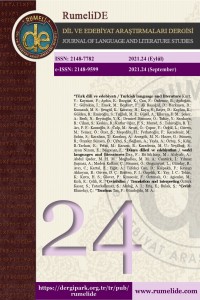Schrader’in Dört Bölümde Bir Yaşam filminde Mişima’nın üç romanının ve sarsıcı “ölüm-öyküsü”nün sinemalaştırılması
Abstract
Paul Schrader’in Mişima: Dört Bölümde Bir Yaşam (1985) filmi Japon yazar Yukio Mişima’nın sansasyonel ölümünün gölge düşürdüğü edebiyatı ve yaşamını en kapsamlı olarak ele alan yaşam-öyküsel temsillerden biridir. Belgesellikle kurmaca arasında gidip gelen ve çok-katmanlı, karmaşık bir zamansal yapıya sahip olan bu eserde Schrader Mişima’nın Altın Köşk Tapınağı (1956), Kyōko’nun Evi (1959) ve Kaçak Atlar (1969) romanlarını, ayrıca buna koşut olarak yazarın yaşam-öyküsel anekdotlarını veciz bir biçimde sinemalaştırır. Hikâyenin merkezinde Mişima’nın 25 Kasım 1970’te, kendi milis gücü Kalkan Topluluğu’ndan dört genç fedaisiyle Japon Öz-savunma Kuvvetleri karargâhında gerçekleştirdiği garip tedhiş (terör) eylemi yer alır. Mişima, bu eylemde yaptığı “restorasyon” çağrısı karşılıksız kalınca harakiri yaparak intihar etmiştir. Dolayısıyla, bu yaşam-öyküsel film, Mişima’nın ruhundaki, yaşamındaki ve eserlerindeki “ölüm tutkusu”nu temsilleştiren bir içeriğe sahip olduğundan ötürü, filmin türü “ölüm-öyküsü” olarak yeniden adlandırılmalıdır. Öte yandan Schrader, bilinçli olarak Walter Benjamin’in “şok etkisi” (Chockwirkung) kuramını bir yönteme dönüştürmüştür. Benjamin’e göre, “şok etkisi” sinemada imgelerin sürekli ve ani değişmesinden kaynaklanır. Fakat böylelikle üretici bir tutumla bilincini yeniden kurmak zorunda kalan seyirci filmi çok daha etkili bir şekilde kavrar. Bu makalede amacımız Schrader’in filmde Benjamin’in “şok etkisi” kuramından nasıl yararlandığını ortaya koymaktır. Bu maksatla, adı geçen edebî eserler ile bunların film uyarlamaları Mişima’nın “ölüm-öyküsü” ekseninde karşılaştırmalı olarak çözümlenmiştir.
References
- Benjamin, W. (2007). Illuminations—Essays and reflections. (H. Zohn, trans.). Schocken.
- Duhamel, G. (1930). Scenes de la vie future. Mercure de France.
- Erhat, A. (1993). Mitoloji sözlüğü. Remzi.........................................
- Frascella, L., & Weisel, A. (2006). Live fast, die young: The wild ride of making rebel without a cause. Touchstone.
- Freud, S. (2016). Beyond the pleasure principle: Human’s struggle between Eros & Thanatos –libido & compulsion. E-art now.
- Güven, D. Ç. (2020). Doğumunu hatırlayan, ölümünü hazırlayan yazar: Yukio Mişima. Lacivert Öykü ve Şiir Dergisi, 16 (92), 56-59.
- Isoda, K., Ueda, M., Oooka M., Ogata T., Ozaki H., Odagiri S.,... Yamamoto K. (Eds.).(1993). Shinchō Nihon bungaku jiten (『新潮日本文学辞典』). Shinchō.
- Mishima, Y. (1964). Kyōko no Ie. (『鏡子の家』). Shinchō.
- Mishima, Y. (1990). Runaway horses. (M. Gallagher, trans.). Vintage.
- Mishima, Y. (1994). The Temple of the Golden Pavilion. (I. Morris, trans.). Vintage.
- Mishima, Y. (2002). Honba. (『奔馬』). Shinchō.............................................
- Mishima, Y. (2003). Ketteiban Mishima Yukio zenshū 36 kan hyōron. (『決定版 三島由紀夫全集36巻 評論11』). Shinchō.
- Mishima, Y. (2020). Kinkaku-ji. (『金閣寺』). Shinchō.........................
- Ovid. (1958). The metamorphoses. (H. Gregory, trans.).Viking.
- Schrader, P. (2007). Mishima: A life in four chapters. Warner Home Video.
The film adaptation of Yukio Mishima’s three novels and his shocking “death-story” in Schrader’s A Life in Four Chapters
Abstract
Paul Schrader’s Mishima: A Life in Four Chapters (1985) is one of the most comprehensive biographical representations of Yukio Mishima’s literature and life, which were retroactively overshadowed by his sensational death. In this film with a multi-layered and complex temporal structure oscillating between documentary and fiction, Schrader concisely adapts The Temple of the Golden Pavilion (1956), Kyōko’s House (1959), and Runaway Horses (1969), as well as some anecdotal episodes of Mishima, for cinema. The story centres on Mishima’s bizarre act of terror which he executed with his four young soldiers from his militia force, the Shield Society, on November 25, 1970, at the headquarters of the Japan Self-Defence Forces. He committed suicide by seppukku when his call for “Shōwa Restoration” was ignored. Hence, as this biographical film focuses on Mishima’s “death” and his anecdotes connected with his “death wish” rather than on his “life-story,” its genre should be renamed as a “death-story.” On the other hand, Schrader consciously transformed Benjamin’s “shock effect” theory into a method. According to Benjamin, the “shock effect” is caused by the constant and sudden change of images in cinema which subverts the viewer’s consciousness. However, in this way, the spectator, who is forced to re-establish her/his consciousness by taking a productive stance, comprehends the film more efficiently. Our goal is to reveal how Schrader utilised Benjamin’s “shock effect” in his film. To this end, we analysed the above-mentioned literary works and their film adaptations comparatively, with a particular focus on the “death-story” of Mishima.
Keywords
Literature and cinema the shock effect The Temple of the Golden Pavilion Kyōko’s House Runaway Horses
References
- Benjamin, W. (2007). Illuminations—Essays and reflections. (H. Zohn, trans.). Schocken.
- Duhamel, G. (1930). Scenes de la vie future. Mercure de France.
- Erhat, A. (1993). Mitoloji sözlüğü. Remzi.........................................
- Frascella, L., & Weisel, A. (2006). Live fast, die young: The wild ride of making rebel without a cause. Touchstone.
- Freud, S. (2016). Beyond the pleasure principle: Human’s struggle between Eros & Thanatos –libido & compulsion. E-art now.
- Güven, D. Ç. (2020). Doğumunu hatırlayan, ölümünü hazırlayan yazar: Yukio Mişima. Lacivert Öykü ve Şiir Dergisi, 16 (92), 56-59.
- Isoda, K., Ueda, M., Oooka M., Ogata T., Ozaki H., Odagiri S.,... Yamamoto K. (Eds.).(1993). Shinchō Nihon bungaku jiten (『新潮日本文学辞典』). Shinchō.
- Mishima, Y. (1964). Kyōko no Ie. (『鏡子の家』). Shinchō.
- Mishima, Y. (1990). Runaway horses. (M. Gallagher, trans.). Vintage.
- Mishima, Y. (1994). The Temple of the Golden Pavilion. (I. Morris, trans.). Vintage.
- Mishima, Y. (2002). Honba. (『奔馬』). Shinchō.............................................
- Mishima, Y. (2003). Ketteiban Mishima Yukio zenshū 36 kan hyōron. (『決定版 三島由紀夫全集36巻 評論11』). Shinchō.
- Mishima, Y. (2020). Kinkaku-ji. (『金閣寺』). Shinchō.........................
- Ovid. (1958). The metamorphoses. (H. Gregory, trans.).Viking.
- Schrader, P. (2007). Mishima: A life in four chapters. Warner Home Video.
Details
| Primary Language | English |
|---|---|
| Subjects | Linguistics |
| Journal Section | World languages, cultures and litertures |
| Authors | |
| Publication Date | September 21, 2021 |
| Published in Issue | Year 2021 Issue: 24 |


